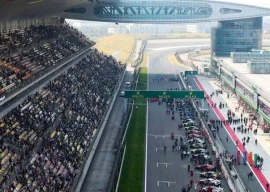
LAHORE: Air pollution in the city has increased after the monsoon season and will rise further till December, an Environment Protection Agency (EPA) official told The Express Tribune on Friday.
A senior official in EPA’s research department said that the levels of fine dust (particle matter 2.5) and nitrogen dioxide recorded after September 16 were significantly more than the permissible levels.
During last week, PM 2.5 (the concentration of fine particles below 2.5 micron, that can have an adverse effect on lungs) average was recorded at 98.13 ug/m3, more than twice the permissible limit of 40.
The average concentration of nitrogen dioxide was recorded at 84.13ug/m3, the safe level is 80.
The overall air quality rating for the last week was around 110.5. It fell in the unhealthy bracket of the EPA’s National Ambient Air Quality Standard.
Though there is no comprehensive study on the effect of air pollution in the country, the EPA figures show a marked deterioration in the air quality of Lahore.
The official said that the increased use of generators and automobiles, especially two-stroke rickshaws, combined with no rainfall will cause the level of pollution to rise further up till December.
The EPA routinely measures air pollution indicators from its Townhall, Gulberg and Township centres. For some time now, it is only taking readings from Townhall and Gulberg office as the one in Township is non-functional.
The official said that the readings taken from Townhall had always been beyond the permissible levels, at times more than twice the levels. Since mid September, the official said, data recorded at Gulberg was also significantly above the permissible levels.
The PM 2.5 ratings calculate tiny particles or droplets in the air, two-and-a-half microns or less in width. These particles are hazardous for human health as they can travel deep into the respiratory tract, causing difficulty in breathing. The nitrous oxide can be toxic in large quantities.
Though the EPA keeps an up-to-date repository of air pollution data, the city administration has taken little or no action to control the pollution levels in the city.
Dr Jawad Aslam, a physician, said that with the rise in air pollution levels, the number of patients with lung problems was also increasing.
He said he had been getting increasing number of cases of children with breathing difficulties such as asthma and bronchitis.
Seher Masood, a housewife, said that she wondered why the EPA or the government was not taking any action against the increasing air pollution. “Lahore’s skies used to be clear when I was young. There was no smell of fuel or other pollutants back then,” she added, “Whenever my children are playing outdoors I’m concerned about their health. I wonder how much the air is hurting their lungs.”
Talking to The Express Tribune, environmentalist Rafay Alam said that if the EPA officials were convinced that automobiles were the major cause of rising pollution levels they should make recommendations to the government in this regard.
He said that the air quality in Lahore was the worst in its history.
He said that the Pakistan Environment Council was mandated to set and enforce a public standard for air pollution.
Alam said that the Section 16 of the EPA Act permitted the authority to issue orders against people responsible for polluting the city atmosphere. He added that the EPA track record in issuing orders against polluters and enforcing environment protection standards was very poor.
“They are responsible for enforcing the laws pertaining to environment protection. But the EPA has never been approached the police against any polluter.”
Published in The Express Tribune, October 9th, 2010.














1713268762-0/Netflix-(3)1713268762-0-270x192.webp)


1713264570-0/Tribune-Collage-Feature-Images-(9)1713264570-0-270x192.webp)

















COMMENTS
Comments are moderated and generally will be posted if they are on-topic and not abusive.
For more information, please see our Comments FAQ